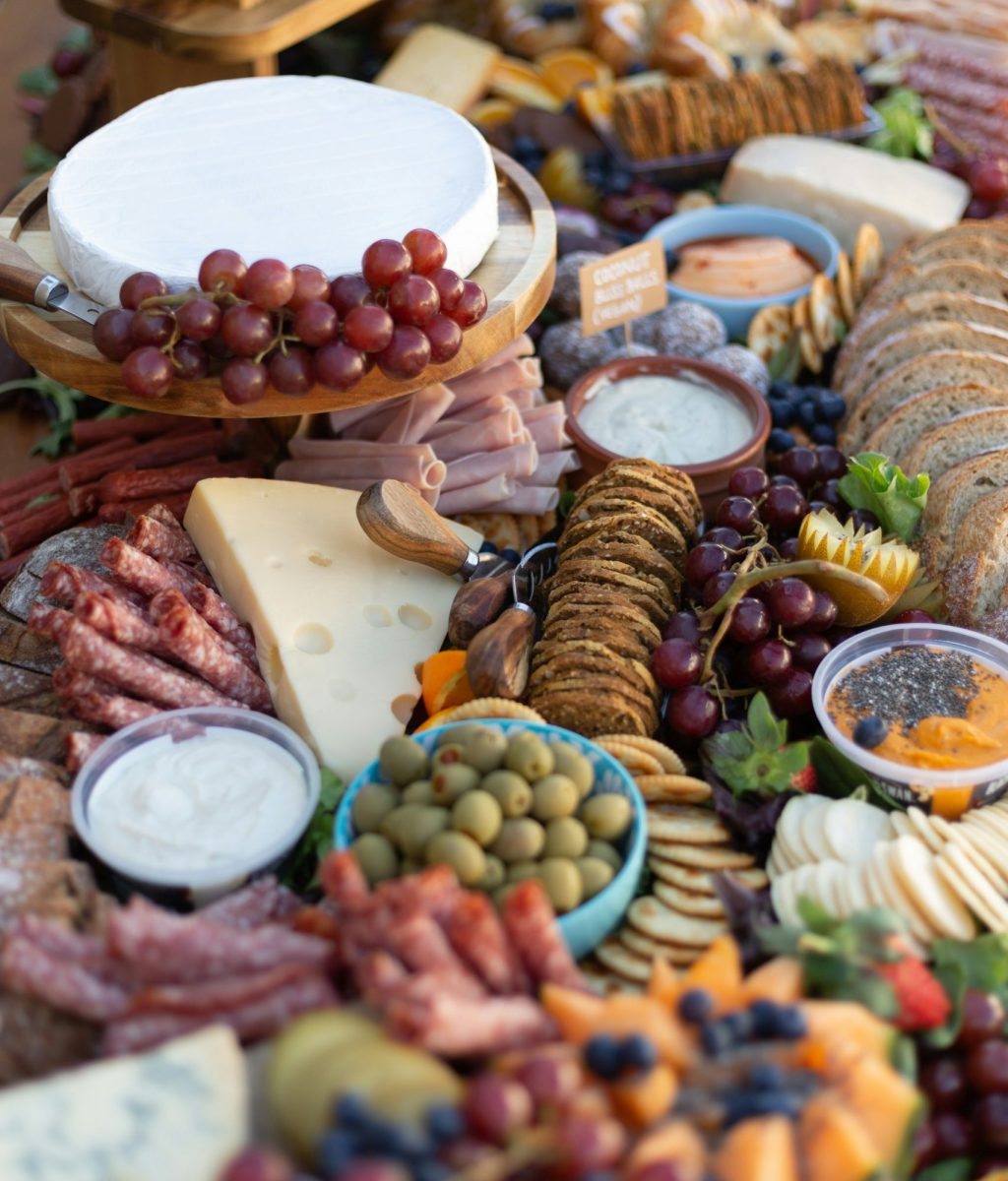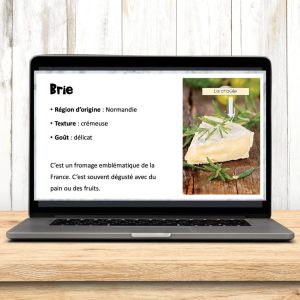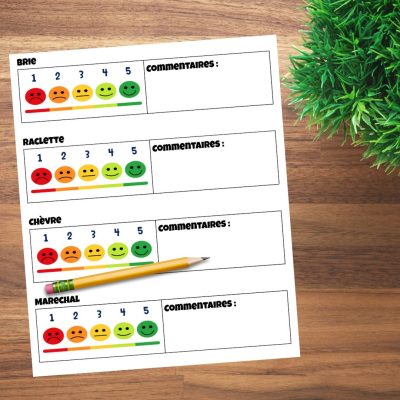
Hosting a French cheese tasting event is a wonderful opportunity to immerse your French students in the rich and diverse culinary culture of France. In France, cheese is not just food – it’s tradition, an art, and a passion applicable to everyday life. Recently, our French club organized a French cheese tasting event, and it was a tremendous success among our students!
In this blog post, I will share valuable tips and tricks to help you plan and execute a successful French cheese tasting event, ensuring an engaging and memorable experience for all.
Step 1: Plan Ahead
You will want to set a date and decide where the French cheese tasting event will take place. We decided to have our event in the classroom and picked a date that was convenient for the majority of our French club members.
Subsequently, you will need to determine your budget for the event, considering the cost of cheese, accompaniments, decorations, etc. Thankfully we ran this as our French Club cultural event and had all expenses covered by our student council. We spent roughly $80 in total and got a deal on our cheeses because one of our French club members works at Vincenzo’s and was able to get a discount on the cheeses.

A French cheese tasting event can be very costly but there are many ways that you can make this a “cost-effective” event. Consider contacting your department head, principal, or parent council and inquire about funds for a cultural event. You could also buy your cheeses at Costco to help reduce spending.
Next, you will want to think about how you will advertise the French cheese tasting event. You could make an announcement, a social media post, hang posters around the school, create a mandatory Google Form registration or let the event travel by word of mouth. We decided to keep our French cheese tasting event as a private event for our loyal French club members because we wanted to make sure that we had enough cheese for all participants and didn’t want people coming just for the food.
Step 2: Curate Your Cheese Selection
Subsequently, you will want to provide a diverse selection of cheeses representing different regions in France or other francophone areas. You can also think about using various types of cheese (hard, blue, goat, soft, etc.). The options are endless!
We targeted four French cheeses for our event: Brie, Chèvre, Marechal, and Raclette. We decided that four cheeses were enough to provide a good variety without overwhelming the participants.
There are also many other classic French cheeses to consider, such as Camembert, Roquefort, Comté, and Reblochon. Each of these cheeses offers a unique taste and texture profile, adding depth to your tasting experience.

Step 3: Calculate the Cheese Quantities
Following that, you will need to use some math skills in order to calculate cheese quantities for the participants. We have a consistent number of students who attend our French club so we planned for that amount plus an additional ten students. We then calculated 30 grams of each cheese for each student. This was the recommended quantity we found online for a French cheese tasting event and it worked out perfectly.
To break it down, if you anticipate 20 regular attendees plus 10 extra, you’ll need cheese for 30 participants. For each cheese, this amounts to:
- 30 participants x 30 grams = 900 grams of each cheese
This calculation ensures that each participant gets a sufficient taste of each cheese without running out. Keep in mind that it’s always better to have a little more than to run out.
Step 4: Decide Your Accompaniments and Beverages
In addition, you will want to decide what accompaniments and drinks to serve with the cheese for your French cheese tasting event. We decided to have a couple of baguettes and crackers. However, you can also provide some fresh fruit (grapes, apples, pears). These are also great additions and substitutes for students who have food intolerances towards cheese but still want to participate in the French cultural event.
We also decided to go over and beyond and bought some fancy sparkling juice (grape, cranberry, and peach) along with elegant, gold-rimmed plastic cups to elevate the event’s ambiance. Our students said that they felt as if they were attending a sophisticated affair.

Adding these extra touches not only enhanced the overall experience but also contributed to creating a memorable and enjoyable atmosphere. It’s the little details that make all the difference and leave a lasting impression on attendees.
Step 5: Presentation and Atmosphere
On the day of the French cheese tasting event, you will want to label each cheese with its name, region, and type in order to educate your students. I would also suggest arranging the cheeses from mildest to strongest to help guide your students’ tasting experience.
For our event, we decided to pre-cut the cheeses and divide them on plates ahead of time so that it was an easy grab-and-go and students weren’t helping themselves. We then had a PowerPoint presentation to accompany the process and included little facts about each cheese.
We also had a station for drinks and accompaniments, allowing students to help themselves throughout the French cheese tasting event. This self-serve station features a selection of refreshing beverages and a wonderful alternative to our dairy-free students who still wanted to join in on the fun.
We also wanted to set the mood for our students and play French music in the background. Here is an example playlist from YouTube that includes hours of classical French café music.
Step 6: Educate and Engage
As a final point, you will want to think of diverse ways that you can educate and engage your attendees throughout the event. At the beginning of our French cheese tasting event, we provided students with infographics about various cheeses and statistics on them. We had classical French music playing in the background to set the mood and had our PowerPoint presentation up and ready to go. Other possible ideas could include cheese trivia, a cheese quiz, or a Kahoot game to help activate prior knowledge before the French cheese tasting event officially begins.

Afterwards, we watched a short YouTube clip from French Chit-Chat with Dylane on les fromages français. The clip was great because the YouTubeur talked slowly and introduced some popular French cheeses, the different types of cheese, how they are to be eaten, and the importance of cheese to the French diet. If you look at this site, there are French and English transcripts to accompany the short video.
The students then received their voting slips for the different cheeses we would be tasting, along with different adjectives to help describe cheeses in French (ex. Dégoûtant, délicieux, fondu, savoureux, etc.). They were expected to rate each cheese on a scale of 1 (disgusting) to 5 (delicious).
Then, we introduced the process and started with our first cheese. We talked about its region of origin, texture, general taste, and a simple fact about it. We gave students about 5 minutes to enjoy the cheese, record their notes, and converse with their peers. We then moved on to the next cheese and completed the same process. In the meantime, students were able to help themselves to crackers, baguettes, and juice in between the tastings.

Once all four cheeses were completed, we collected all of the students’ voting slips and counted them up. To conclude the event, we revealed the “cheese winner” that was the most popular amongst our students. Our students overwhelmingly favored Brie followed closely by chèvre and then marechal.
This final activity not only added an element of fun and competition to the event but also provided valuable feedback on the preferences of our participants. It was a great way to wrap up the French cheese tasting event and leave everyone with a sense of satisfaction and solidarity.
French Cheese Tasting Event Conclusion
Hosting a French cheese tasting event is not only about savoring delicious cheeses but also about celebrating French culture and creating a shared experience among the participants. We were fortunate to have had someone from our school’s yearbook committee capture the moment of our event. These pictures will showcase memorable moments and the joy shared by everyone, allowing us to reminisce and promote the vibrant activities of our French Club in our yearbook.
With careful planning and passion for French gastronomy, your French cheese tasting event will be a memorable success that delights all participants. Bon appétit, and may your French cheese tasting event be a true celebration of French culture and foster a sense of community!
Bonne chance,
Emily
